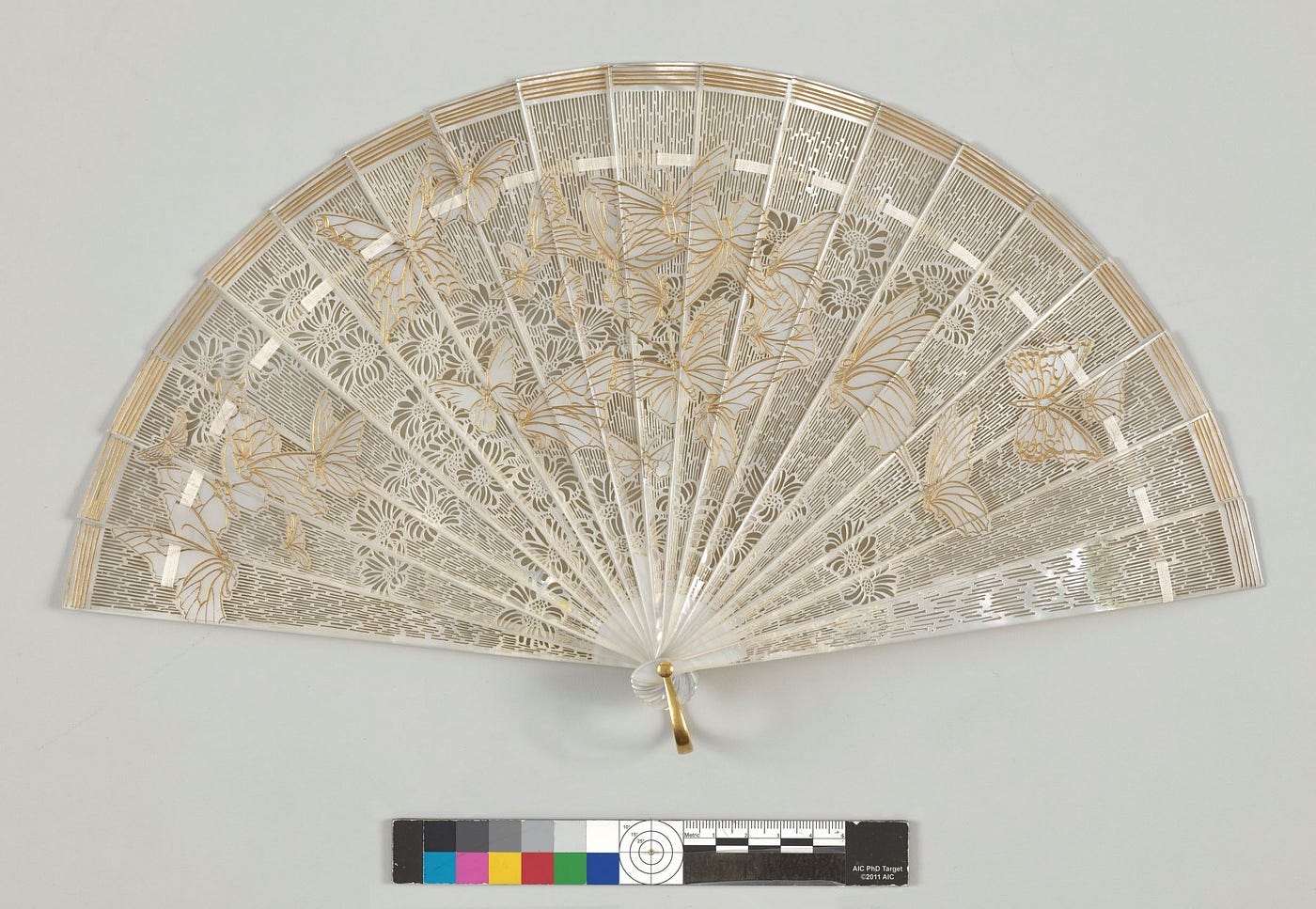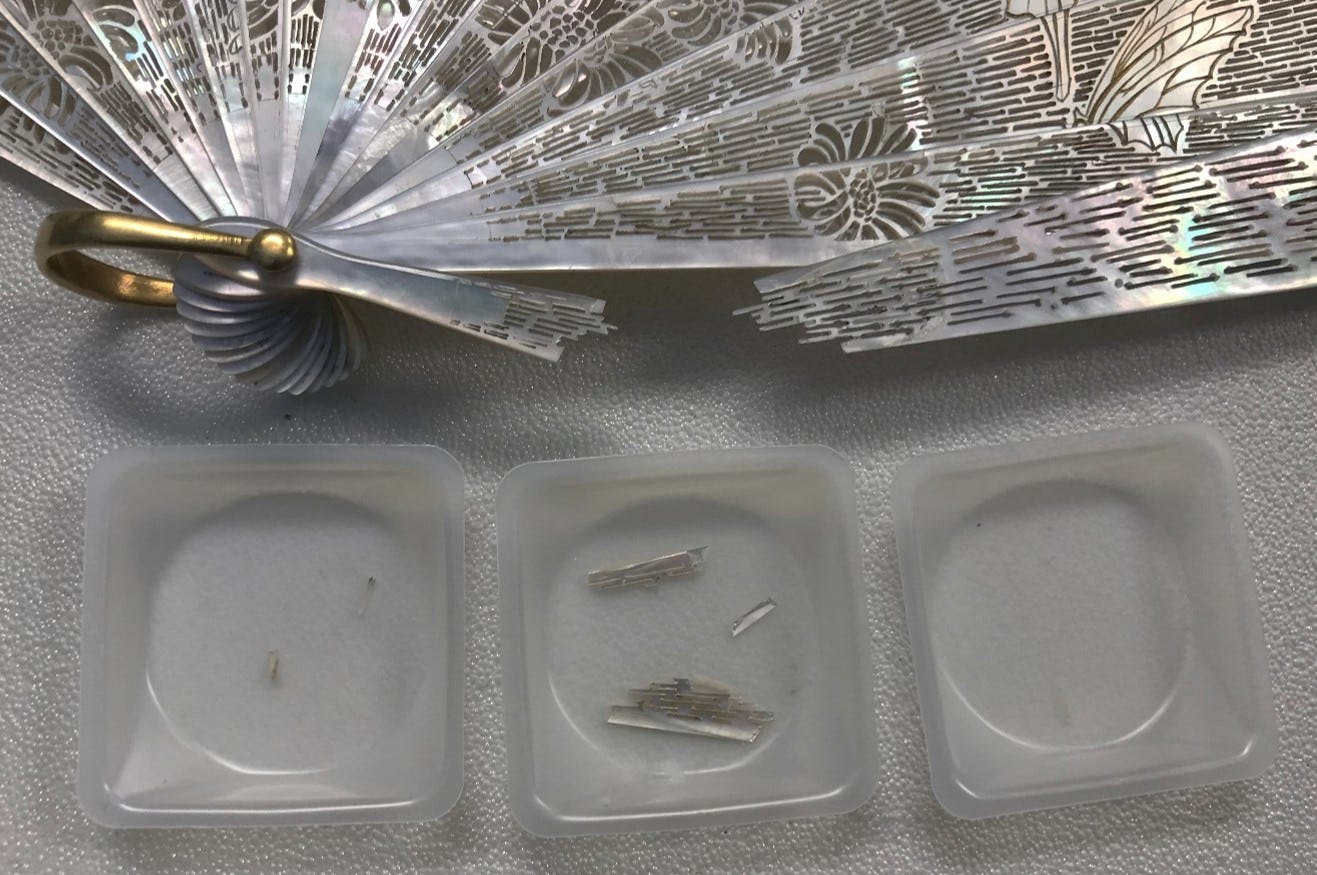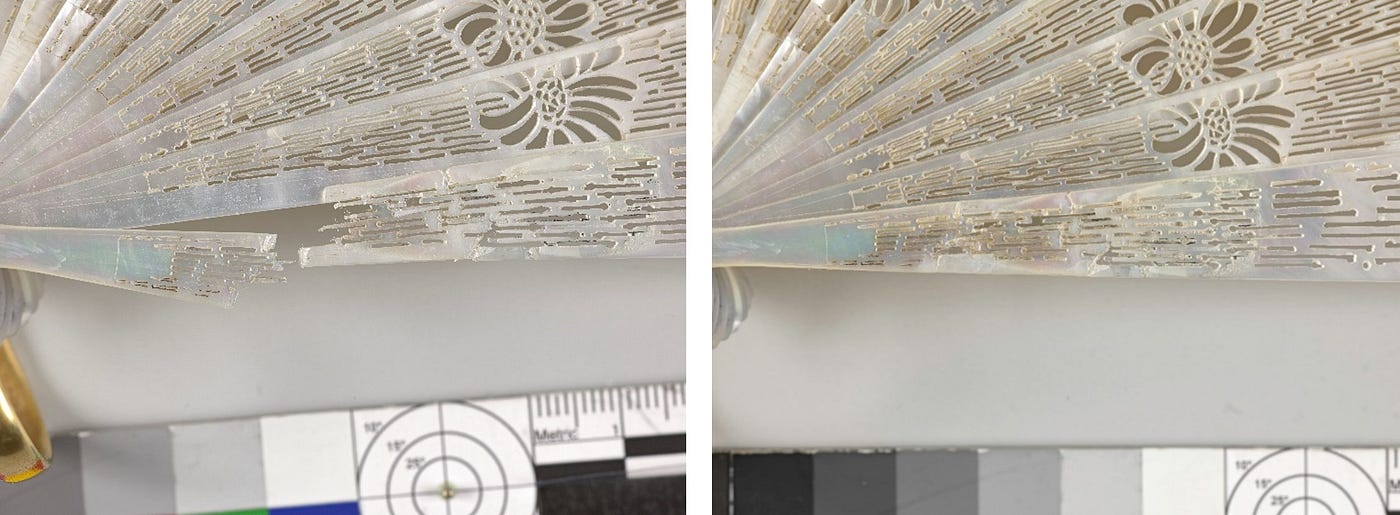[ad_1]
By Adrienne Gendron, Gradutate Intern in Objects Conservation at the CMA

Number of materials embody luxurious far more completely than mother-of-pearl and gold. This mother-of-pearl admirer is composed of 19 slats with gold-colored inlay and cutout styles showcasing butterflies and bouquets (fig. 1). The lover was designed by René Lalique, a French jeweler and glassmaker performing at the height of the Artwork Nouveau movement in the early 20th century. At that time, artists commenced to refocus on the value of the individual artist’s hand immediately after a period of fascination with industrial processes. The Artwork Nouveau movement introduced an appreciation for natural varieties, references to the pure earth, and an affinity for Japanese model. Concurrently, there was an outpouring of inventive energy into the realm of decorative arts, ensuing in a loaded period of time of creativity and ornamentation of day-to-day objects. Lalique was heralded as “the best jeweler working in France” and was regarded for using resources animated by light-weight (Harrison 2008, 29).
The mother-of-pearl made use of to generate this Lalique admirer is really slim (about the thickness of a quarter) and made even more sensitive due to the intricate cutout types. Yrs back, a person of the slats broke into various items. Earlier restore tries utilised an adhesive, but with this kind of a small surface location to join, the repairs ended up inherently weak and unsuccessful consistently. As aspect of my graduate internship with the museum’s objects conservation lab, I was questioned to uncover a greater remedy to this hard dilemma.

To do this, it is vital to assess an item and determine the most correct procedure. Just after investigating the object’s cultural context, I determined that, as an Art Nouveau luxurious attractive arts object, the fan’s beautiful visual appeal is paramount to its main which means. The item is no longer visually coherent in its existing broken state, and restoring it would return a diploma of visual legibility to the object constant with Lalique’s artistic custom. Its current affliction also renders the object unstable and vulnerable to even more damage, so fixing the place would limit possibility. With these issues in thoughts, I made the decision to discover as a great deal as I could about the object and how it was made, in purchase to establish an suitable therapy program.



Inspecting the enthusiast beneath a microscope revealed intriguing aspects. Though at first look the slats seem to be built in one particular piece, skillfully executed joins are obvious below magnification (fig. 3). The artist utilized at least two pieces of mom-of-pearl to produce each and every slat, utilizing a complex splicing system to make the joins as invisible as doable. I could also see that the artist first mapped out the layouts in shallow incised traces (fig. 4). The slim slits ended up built utilizing a tiny drill to pierce holes, which were then elongated into slits with a jeweler’s observed.
The entrance of the admirer is also decorated with incised strains, which are crammed with gold-colored product . The incisions have angled sides, indicating that they had been created utilizing a pointed software. Below the microscope, the gold material appears to be like like many person particles as opposed to a one sheet of metallic, suggesting that it was applied as a powder relatively than as a leaf (fig. 5).

At first look the gold-colored material and steel loop appeared to be pure gold having said that, points are not constantly as they appear! I used transportable X-ray fluorescence (pXRF), a non harmful analytical method that provides data on elemental composition, to come across out additional. I identified that the gold-coloured materials includes brass, a copper and zinc alloy, along with some gold. My assessment of the metal loop advised that it is likely composed of a copper alloy base metal that has been gold plated.

Upcoming, I designed mock-ups to achieve a palms-on comprehending of how the fan was made. Employing sample items of mother-of-pearl, I established incised channels with a Dremel resource and tested a few strategies of making use of gold-colored fill: flash gilding (gold powder utilized more than a binder), shell gold (gold particles suspended in a gum arabic medium and used as paint), and mordant gilding (gold leaf used over a binder) (fig. 6). I discovered that the flash gilding process gave an overall look most comparable to the parts on the Lalique admirer. This theory is more supported by the existence of stray gold-colored particles in regions of the supporter not intended for decoration, which could quickly manifest when functioning with unfastened powder (fig. 7).

The harm to the fan’s outermost slat had resulted in a intricate split with several separate items. Since preceding repair tries utilizing adhesive by itself experienced failed, I made the decision to check out using a backing content to help the ruined region from guiding. I chose Mylar, a slim polyester movie, as it is clear and would not disrupt the visual impact of the sensitive cutouts but it is also robust and rigid ample to deliver sufficient assistance to the broken region. To examination this system, I designed another mock-up re-building the fan’s cutout system, then broke the mockup in half and adhered the Mylar backing in spot (fig. 8).

Immediately after completing the mock-up, I was able to successfully repair service the first admirer (fig. 9). The outcome is an object that is now visually coherent and steady with the artist’s at first supposed physical appearance (fig. 10). It is also additional structurally secure and can be safely shown in the potential.

Zoom in on this French fan and quite a few others by looking the keyword “fan” in Assortment On line. Which design catches your eye?
[ad_2]
Source link







